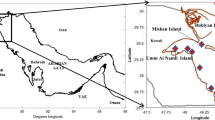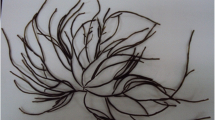Abstract
Dietary antioxidants from plants are believed to help prevent aging and other diseases through radical scavenging activity. Free radical scavenging activities by 1,1-diphenyl-2-picrylhydrazyl (DPPH) assay and deoxyribose assay were ascertained among 27 species of common seaweeds using a sequential extraction method. The results indicated that, DPPH scavenging activity existed in 15 species; Gelidium amansii, Gloiosiphonia capillaris, Polysiphonia urceolata, Sargassum kjellmanianum, Desmarestia viridis, and Rhodomela teres showed the strongest activities. On the other hand, the deoxyribose results showed that almost all the seaweed species had good ability to scavenge hydroxyl radicals. The most active species were Rhodomela teres and Chorda filum.
Similar content being viewed by others
References
Harman D (1981) The aging process. Proc Natl Acad Sci USA 78: 7124–7128.
Kehrer JP (1993) Free radicals as mediators of tissue injury and disease. CRC Crit Rev Toxicol 23: 21–48.
Niki E (1990) Defense system against oxygen toxicity in vivo. Kikan Kagaku Sosetsu 7: 177–190.
Nakano M (1997) Function of antioxidants of plant origin. Food Chem 1: 67–69.
Tsushida T, Suzuki M, Kurogi, T (1994) Evaluation of antioxidant activity of vegetable extracts and determination of some active compounds. Nippon Shokuhin Gakkaishi 41(9): 611–618.
Nakatani N (1993) Antioxidants isolated from spices. Food and Food Ingredients Journal 157: 54–60.
Fujimoto K, Ohmura H, Kaneda T (1985) Screening test for antioxygenic compounds from marine algae and fractionation from Eisenia bicyclis and Undaria pinnatifida.Bull Jpn Soc Fish 46(9): 1125–1130.
Yan XJ, Li XC, Zhou CX, Fan, X (1996) Prevention of fish oil rancidity by phlorotannins from Sargassum kjellmanianum. J Appl Phycol 8: 201–203.
Brand-Williams W (1995) Use of a free radical method to evaluate antioxidant activity. Food Sci Technol (London) 28: 25–30.
Aruoma OI (1994) Deoxyribose assay for detecting hydroxyl radicals. Method in Enzymol 233: 57–66.
Halliwell B, Gutteridge JMC (1981) Formation of a thiobarbituric acid reactive sub-stance from deoxyribose in the presence of iron salts. FEBS Lett 128: 347–352.
Nishino H (1995) Cancer chemoprevention by natural carotenoids and their related compounds. J Cell Biochem Suppl 22: 231–235.
Yan XJ (1996) Quantitative determination of phlorotannins from some Chinese common brown seaweeds. Studia Marina Sinica 37: 61–65.
Author information
Authors and Affiliations
Rights and permissions
About this article
Cite this article
Yan, X., Nagata, T. & Fan, X. Antioxidative activities in some common seaweeds. Plant Foods Hum Nutr 52, 253–262 (1998). https://doi.org/10.1023/A:1008007014659
Issue Date:
DOI: https://doi.org/10.1023/A:1008007014659




